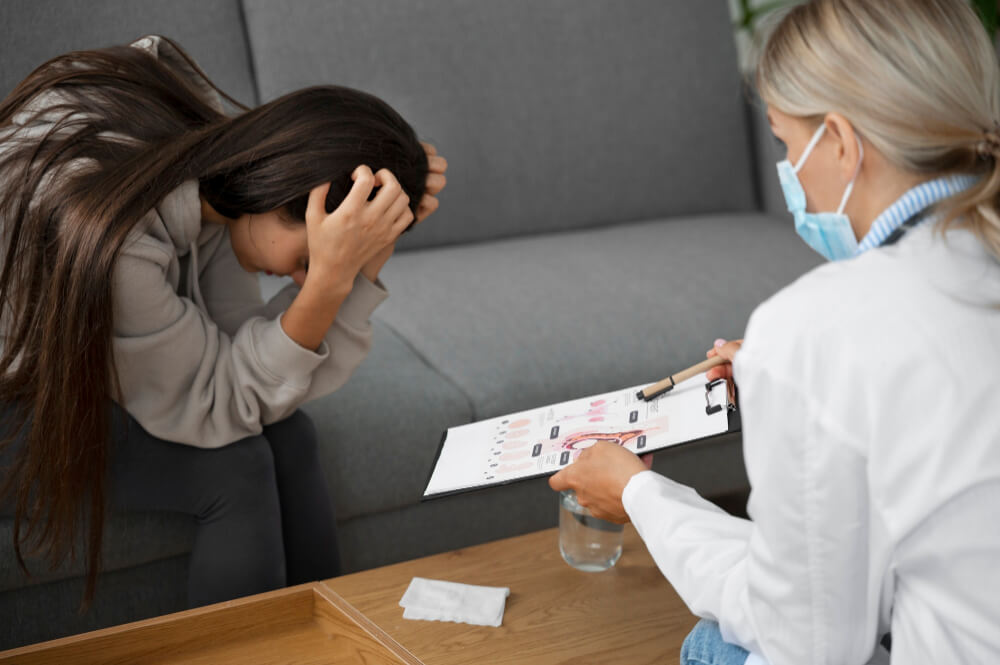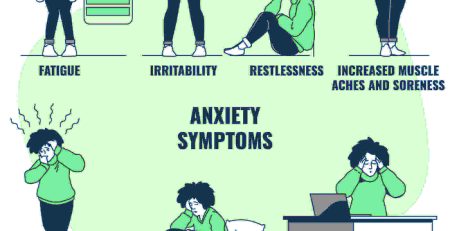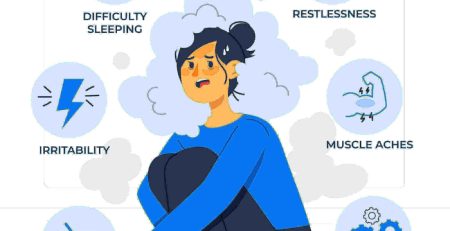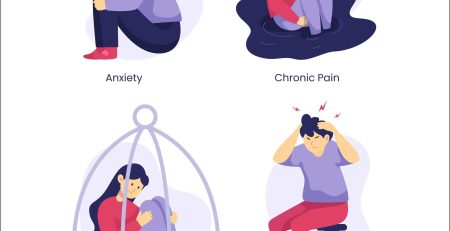Anxiety Disorder Myths: Unraveling the Truth
Mybestmentalhealth2023-12-09T19:27:47+00:00Anxiety disorder is a mental health condition characterized by excessive fear and worry. It affects daily functioning and can cause intense emotional distress.
Understanding anxiety disorder is crucial as it can disrupt an individual’s ability to lead a normal life. It manifests through various symptoms such as panic attacks, obsessive thoughts, unrelenting worries, and irrational fears. While everyone experiences anxiety at one point or another, anxiety disorders are more severe, often chronic, and can require professional treatment to manage effectively.
Common types include generalized anxiety disorder, social anxiety disorder, and panic disorder, among others. Timely intervention and a combination of therapeutic strategies can significantly improve the life quality of those dealing with this condition. It’s important to recognize the signs and seek help early to manage symptoms effectively.
What Is Anxiety Disorder?
When whispers of worry become deafening roars of distress, it might signal the presence of a complex mental health condition known as an anxiety disorder. This is not the common unease felt before a significant event, but rather an overwhelming wave of fear that can be crippling to daily functioning. Understanding anxiety disorder is pivotal in recognizing its impact and seeking appropriate treatment. In this exploration, let’s dive into the nature of anxiety disorder, unraveling its core definition and array of symptoms, followed by a comprehensive look into the various types of disorders under its umbrella.
Definition And Symptoms
Anxiety disorder goes beyond the occasional nervousness or stress. It encompasses a group of mental illnesses that consistently wreak havoc in an individual’s life. These disorders trigger intense, excessive, and persistent worry and fear about everyday situations, often interfering with daily activities.
- Feelings of panic, fear, and uneasiness
- Sleep issues, such as insomnia triggered by a restless mind
- Cold or sweaty extremities and tremors
- Shortness of breath, which might mirror symptoms of a heart attack
- Dry mouth and difficulty swallowing
- Nausea paired with abdominal distress
- Dizziness that can disrupt balance and focus
- Muscle tension, often chronic and without a specific cause
These symptoms can lead to a self-perpetuating cycle, where the dread of experiencing anxiety itself exacerbates the condition.
Types Of Anxiety Disorders
Mental health experts recognize several types of anxiety disorders, each with distinct features:
| Type of Disorder | Description |
|---|---|
| Generalized Anxiety Disorder (GAD) | Characterized by chronic anxiety, exaggerated worry, and tension without specific triggers. |
| Panic Disorder | Features spontaneous and repeated episodes of intense fear, alongside physical symptoms like chest pain, palpitations, and shortness of breath. |
| Phobias | Includes disorders with an intense, irrational fear of specific objects, activities, or situations leading to avoidance behavior. |
| Social Anxiety Disorder | Encompasses overwhelming worry and self-consciousness about daily social situations, rooted in a fear of scrutiny or judgment by others. |
| Obsessive-Compulsive Disorder (OCD) | Involves recurrent unwanted thoughts (obsessions) and/or repetitive behaviors (compulsions). |
| Post-Traumatic Stress Disorder (PTSD) | May develop after exposure to a terrifying event or ordeal involving physical harm or the threat thereof. |
Each disorder demands a tailored treatment strategy to manage symptoms effectively and improve quality of life.
Causes And Triggers
Anxiety disorders envelope a multitude of conditions where the primary symptom is excessive, irrational dread and fear. Understanding the root causes and triggers is crucial in managing and treating anxiety. With a myriad of intertwined factors at play, it’s essential to unravel the complexities of anxiety’s onset. These influences can be biological, stemming from genetics or brain chemistry; environmental, influenced by surroundings and experiences; or the result of stress and traumatic events. A deeper dive into each of these categories reveals the multifaceted nature of anxiety disorders.
Biological Factors
Genetics have been recognized as one of the significant contributors to anxiety disorders. While it’s not as simple as inheriting anxiety from one’s parents, a family history of anxiety can increase predisposition risks. Neurological imbalances, particularly in brain chemicals such as serotonin and dopamine, also play a central role in anxiety manifestations. The complexity of the human brain means that small chemical shifts can have profound effects on mood and behavior.
In addition, physical health conditions can act as catalysts. Conditions like thyroid problems, heart arrhythmias, or caffeine and substance abuse can mimic or worsen anxiety symptoms. Regular medical check-ups are vital to rule these out as underlying causes.
Environmental Factors
Our surroundings and life experiences heavily influence our psychological well-being. Childhood environment, including exposure to abuse or neglect, sets the foundation for our future mental health. Similarly, ongoing stress from a job, relationship struggles, or financial pressures contributes greatly to the development of an anxiety disorder.
- Major changes or life transitions such as starting a new job, moving to a new city, or losing a loved one can serve as triggers.
- Limited social support can leave individuals feeling isolated, which may escalate stress and cultivate anxiety.
Stress And Trauma Triggers
Stressful life events have a notable impact on mental health. High levels of stress, whether acute or chronic, can trigger symptoms of anxiety or full-blown anxiety disorders. Prolonged stress can lead to a state of heightened anxiety and vulnerability to panic attacks.
Traumatic experiences, such as military combat, accidents, or personal assaults, can lead to post-traumatic stress disorder (PTSD), a specific type of anxiety disorder. The onset of PTSD symptoms can occur immediately after the event or surface years later, causing intense anxiety and fear.
It’s also worth noting the impact of smaller, everyday stressors that accumulate over time, contributing to a state of continual anxiety. Recognizing these triggers is a step toward effective management and treatment strategies.
Effects On Mental Health
Anxiety disorders encompass a range of mental health challenges that can profoundly impact an individual’s psychological well-being. These disorders do not quietly fade into the background; rather, they persistently intrude on daily life, influencing behavior, thoughts, and feelings. With physical symptoms often mirroring the psychological tumult, anxieties deepen their roots affecting mental health profoundly.
Impact On Daily Life
The pervasive nature of anxiety disorders can grind down one’s daily routine to a halt. From the moment waking up feels burdened with worry, through the day where concentration falters, to the point where falling asleep becomes a nightly struggle, anxiety is relentlessly taxing. Individuals may experience:
- Procrastination and avoidance behaviors due to overwhelming anxious thoughts.
- Decreased productivity at work or school as a result of difficulty focusing.
- Persistent feelings of distress in situations that used to be manageable.
- Physiological symptoms such as rapid heartbeat, sweating, trembling, and fatigue.
Relationship And Social Implications
When anxiety casts its shadow, relationships and social encounters don’t escape unscathed. Social anxiety, for instance, can instill a paralyzing fear of judgment or embarrassment, making interactions exceedingly stressful. The consequences of such anxiousness manifest in different ways:
| Relationship Aspect | Implications of Anxiety |
|---|---|
| Communication | Difficulties in expressing oneself, resulting in misunderstandings and heightened tensions. |
| Intimacy | Withdrawal from close relationships, or an inability to forge new ones, due to fear of rejection or overbearing nervousness. |
| Social Activities | Avoiding social gatherings, which can lead to isolation and exacerbate feelings of loneliness and depression. |
| Support Networks | Struggles in maintaining a support network, hindering the ability to seek or offer help during tough times. |
Within this matrix of anxiety, the ripple effect is clear—young or old, the emotional toll on personal and social well-being is undeniable. The path to coping with an anxiety disorder is about acknowledging its presence and understanding its widespread effects on mental health. Only then can effective management and treatment strategies be implemented to mitigate these life-altering consequences.
 Image by Freepik
Image by Freepik
Diagnosing Anxiety Disorder
An accurate diagnosis is the cornerstone of any effective treatment strategy, especially when dealing with complex conditions like Anxiety Disorders. Understanding the process of diagnosing Anxiety Disorders helps in demystifying the path from confusion and distress to clarity and support. This critical journey often commences with a thorough assessment, inevitably leading to professional evaluation and care. The following detail provides insights into each phase of the diagnosis process, reinforcing the essential steps towards managing and overcoming Anxiety Disorders.
Assessment And Evaluation
The initial phase in diagnosing an Anxiety Disorder involves a comprehensive assessment that examines both psychological and physical health. This process may include the following:
- Personal History: A detailed conversation to capture symptoms, personal struggles, and any contributing factors such as traumatic events or family history of anxiety.
- Questionnaires or Screening Tools: Standardized forms to quantify anxiety levels and to discern patterns related to various anxiety disorders.
- Physical Examination: A health check to rule out underlying medical conditions that could be causing or exacerbating symptoms.
- Laboratory Tests: Bloodwork and other tests can be ordered to eliminate physical health concerns.
It’s not uncommon for patients to find comfort in this structure, as it provides a foundation to not just qualify their experiences but quantify them in a way that can be addressed.
Seeking Professional Help
After the initial assessment, the next critical step is seeking professional help. This stage typically involves:
- Consulting with a mental health professional such as a psychologist, psychiatrist, or clinical social worker familiar with anxiety disorders.
- Engaging in detailed discussions about mental health to identify patterns indicative of a specific disorder.
- Discussing treatment options tailored to the individual’s needs, which may include therapy, medication, or a combination of both.
Engaging with professionals trained to combat anxiety ensures that individuals receive evidence-based treatment and a supportive path forward. Remember, the right professional can make a monumental difference in your mental health journey.
Treatment Options
Anxiety disorders present a multifaceted challenge to those affected, permeating daily routines with persistent and overwhelming feelings of worry and fear. Fortunately, a range of effective treatment options exists to combat this condition, offering hope and relief. By tailoring approaches to individual needs, anxiety can be managed and controlled. In this section, we delve into the various therapies, medications, and alternative methods available to help individuals regain a sense of normalcy and well-being.
Therapy And Counseling
Engaging with a mental health professional is a cornerstone of treating anxiety disorders. Tailored to meet the unique needs of the individual, therapy can empower and equip with strategies necessary for overcoming anxiety. The most effective therapy approaches below:
- Cognitive-Behavioral Therapy (CBT): Concentrates on recognizing and altering detrimental thought patterns.
- Exposure Therapy: Involves gradual exposure to the source of anxiety to diminish fear.
- Acceptance and Commitment Therapy (ACT): Encourages acceptance of feelings rather than fighting them.
Consistent counseling sessions can lead to significant improvements, with many individuals experiencing a reduction in their anxiety symptoms.
Medication And Alternative Therapies
Medication can be a vital part of a comprehensive treatment plan, often used in conjunction with therapy. Medications such as antidepressants, anti-anxiety medications, and beta-blockers can provide relief, stabilize mood, and reduce the physiological symptoms of anxiety. However, it’s crucial to discuss the potential benefits and side effects with a healthcare professional before starting any medication.
Beyond traditional medication, numerous alternative therapies offer additional avenues of support:
| Alternative Therapy | Description | Benefits |
|---|---|---|
| Mindfulness and Meditation | Practices that promote relaxation and present-moment awareness. | Reduces stress levels and improves emotional regulation. |
| Exercise | Physical activity that stimulates the release of stress-relieving hormones. | Boosts mood, enhances sleep, and provides a sense of accomplishment. |
| Herbal Supplements | Natural compounds such as valerian root, chamomile, or lavender. | May have a calming effect and support overall mental health. |
Whether choosing medication, therapy, or alternative treatments, a holistic approach that addresses both the mind and body often yields the best outcomes. Always consult with a healthcare provider to determine the most suitable options for your situation.
Coping Mechanisms
Anxiety disorders are among the most prevalent mental health conditions, affecting individuals deeply in their daily lives. Finding effective coping mechanisms can be a transformative step towards managing symptoms and improving overall well-being. Below, explore various strategies and supportive practices that empower individuals to regain control and navigate the challenges of anxiety with greater ease.
Self-care practices
Self-care Practices
Integrating self-care into your routine is foundational in mitigating the impact of anxiety. This section will delve into activities and habits that fortify mental health and bolster resilience against stress.
- Mindfulness and Meditation: Dedicate time daily to mindfulness exercises or meditation, techniques proven to reduce stress and improve focus.
- Regular Exercise: Engage in physical activity, which releases endorphins and can significantly lower anxiety levels.
- Healthy Nutrition: Consume a balanced diet rich in nutrients that support brain health and stabilize mood swings.
- Quality Sleep: Ensure adequate sleep, as good rest helps regulate emotions and cope with stress.
- Time Management: Structure your day effectively to minimize overwhelm and create space for relaxation and leisure.
Support systems and resources
Support Systems And Resources
Nurturing a support network is crucial for those living with anxiety. Let’s look at the avenues through which support can be sought and utilized to foster a sense of security and community.
- Professional Therapy: Consider therapy with a licensed counselor specializing in anxiety disorders, offering tailored coping strategies.
- Support Groups: Join support groups to connect with others experiencing similar challenges; sharing experiences can be incredibly validating.
- Online Resources: Utilize reputable online platforms that provide educational content, coping techniques, and community forums.
- Family and Friends: Keep close contacts informed about your condition; their understanding can be a huge pillar of support.
- Emergency Helplines: Have access to crisis lines for immediate help during acute anxiety episodes.
Lifestyle Changes
Adapting one’s lifestyle can have a profound impact on managing Anxiety Disorder. Simple, consistent changes can help build a solid foundation to reduce symptoms and improve overall well-being. From establishing healthy habits to managing anxiety in everyday situations, the goal is to create a balanced routine that supports mental health.
Healthy Habits
Incorporating healthy habits into one’s daily routine is a key step toward managing anxiety. Here are strategies to foster well-being:
- Regular Exercise: Strive to engage in moderate activity for a minimum of 30 minutes on most days.
- Sufficient Sleep: Make it a priority to get 7-9 hours of restful sleep every night..
- Balanced Diet: Choose whole foods, minimize processed foods, and stay hydrated.
- Mindfulness Practices: Engage in activities like yoga, meditation, or deep-breathing exercises.
- Social Connections: Spend time with loved ones or participate in group activities.
Managing Anxiety In Daily Life
Day-to-day anxiety management is crucial. Consider these tips to stay in control:
| Technique | Description | Benefit |
|---|---|---|
| Time Management | Establish a structured routine to reduce stress. | Lowers unpredictability that may fuel anxiety. |
| Thought Record | Keep a journal to track thoughts and triggers. | Helps identify patterns and devise coping strategies. |
| Relaxation Techniques | Practice progressive muscle relaxation or guided imagery. | Decreases immediate stress and calms the mind. |
Remember, small steps can lead to significant improvements in managing Anxiety Disorder. Begin by integrating healthy habits and tailor techniques to fit within your daily life for the best outcome.
Frequently Asked Questions Of Anxiety Disorder
What Is Anxiety Disorder?
An anxiety disorder is a mental health condition characterized by persistent, excessive worry affecting daily living.
How Common Is Anxiety Disorder?
Anxiety disorders are among the most common mental health disorders, impacting millions worldwide annually.
What Causes Anxiety Disorder?
Anxiety disorders can result from a combination of genetic, environmental, psychological, and developmental factors.
Can Anxiety Disorder Be Cured?
While anxiety disorder is not curable, it can be effectively managed with therapy, medication, and lifestyle changes.
What Are Symptoms Of Anxiety Disorder?
Symptoms include chronic worry, restlessness, fatigue, difficulty concentrating, irritability, sleep disturbances, and physical tension.
How Is Anxiety Disorder Diagnosed?
Healthcare providers diagnose anxiety disorder using psychological evaluations, symptom assessment, and ruling out other medical conditions.
What Treatments Are Available For Anxiety Disorder?
Treatments include psychotherapy, medications, stress management techniques, and lifestyle modifications to reduce anxiety symptoms.
Conclusion
Understanding anxiety disorders is the first step towards reclaiming control. Remember, you’re not alone in this battle. Reaching out for help, adopting coping strategies, and staying informed creates a solid foundation for managing symptoms. Your mental well-being is paramount; never hesitate to seek support.
Embrace the journey to a calmer mind, starting today.






Leave a Reply